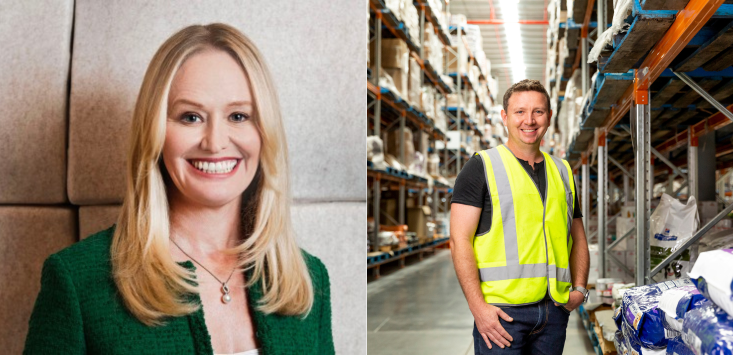
L-R: Chartered Accountants Australia and New Zealand chief executive Ainslie van Onselen and Mike Frizell, Pet Circle CEO. Source: supplied.
In a sea of concerning gender pay gap data, a select few businesses are reporting equity between their male and female employees — and a handful of those have shared what it takes to approach equal pay within the workplace.
New data released by the Workplace Gender Equality Agency (WGEA) on Tuesday shows an average total remuneration gap of 21.7% between men and women, showcasing an economy-wide bias towards men in professional life.
The WGEA data trove also reveals the gender pay gaps of individual businesses with more than 100 employees, providing granular insights into the pay gap at play.
It also allows star performers to stand out.
Chartered Accountants Australia and New Zealand, an industry group representing accountants, has reported a totally even median base salaries between its male and female employees, with a total remuneration gap of 0.5% in favour of men.
The organisation outperforms the average employer in its category, which reports a 5.8% median total remuneration gender pay gap, and the WGEA’s own target of a +/-5% median gender pay gap.
Women account for 59% of its total workforce, with a remarkably consistent gender split from its clerical and administrative workers all the way to its senior managers.
In an additional statement provided to the WGEA, Chartered Accountants Australia and New Zealand explained its internal equity plan, providing a starting point for other businesses considering their own future.
It committed to “regular measuring, tracking and deep diving” into the causes of gender pay gaps in 2021, it said.
“Narrowing the gender pay gap was embedded as a strategic priority for our organisation and has remained a Key Performance Indicator for our Executive Team since that time.
“As a result of this commitment, we have seen a gradual narrowing of both the mean and median pay gaps for our organisation.”
Extra measures undertaken include investment in career pathways for women “from individual contributors into leadership roles”, and an active balancing of the hiring of men and women into lower-paying roles.
Notably, CA ANZ also says it has launched a “gendered intervention focus” to address systemic barriers to employment and leadership faced by women.
In other words, it says it is actively combating the challenges that can cause women to drop out of the workplace.
While the headline results are remarkable in the context of broader industry trends, CA ANZ notes its mean pay gap for the same period is 17.3% for base salary, and 17.1% for total remuneration.
A higher percentage of women in junior roles compared to men, who make up a smaller proportion of workers overall, skews this result.
CA ANZ said “the movement in one man’s salary has a greater impact on the average salary of all men given we employ a much smaller pool of men compared to women.
“Conversely, movement in one woman’s salary has far less impact on the average salary of women given the large numbers of women we employ.”
The next steps to formally close the gender pay gap “requires ongoing vigilance and focus”, CA ANZ said.
No accidents behind pay equity results
The results of another venture show gender pay equity is no accident.
Pet Circle, the unicorn-status pet goods provider, reported a -0.5% median base salary pay gap, and a -0.9% median total remuneration pay gap — that is, pay gaps in favour of the women in its workforce.
That is a standout result, even within the retail trade industry segment, which recorded lower-than-average gender pay gaps.
Millell Pty Ltd, the parent company of Pet Circle, did not publish an optional report as CA ANZ did.
However, Pet Circle has publicly noted its focus on the gender pay gap since at least 2022.
Pet Circle used that year’s International Women’s Day to kickstart a week of “sharing inspiring stories, learning about bias, and using our virtual discussion corner to brainstorm tangible actions we can do each day to break the bias,” the company said.
The common theme is an active effort to address pay disparity — and the WGEA itself is calling on businesses to take notice.
“The time for talk and excuses is over,” WGEA CEO Mary Wooldridge said.
“Change takes action and employers need to double down on ensuring all employees are fairly represented and equally valued and rewarded in their workplace.”
Handpicked for you

Closing the gender pay gap requires redefining Australia’s modern workplace



COMMENTS
SmartCompany is committed to hosting lively discussions. Help us keep the conversation useful, interesting and welcoming. We aim to publish comments quickly in the interest of promoting robust conversation, but we’re a small team and we deploy filters to protect against legal risk. Occasionally your comment may be held up while it is being reviewed, but we’re working as fast as we can to keep the conversation rolling.
The SmartCompany comment section is members-only content. Please subscribe to leave a comment.
The SmartCompany comment section is members-only content. Please login to leave a comment.